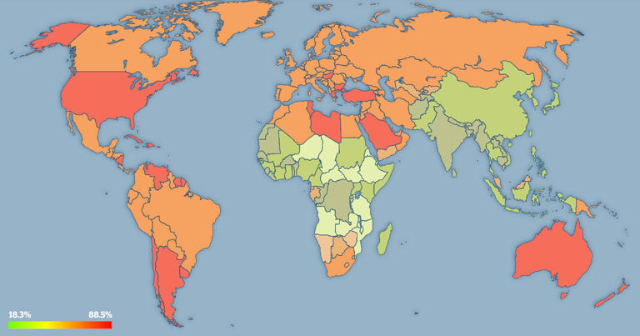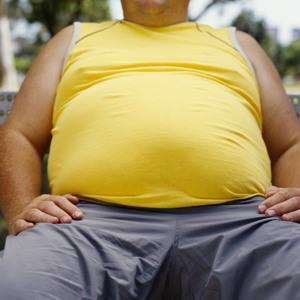We hear all kinds of figures describing the obesity problem. But we rarely see a graphic representation of the global reality. They say a picture is worth a thousand words… Today, we present a map that demonstrates the urgency of the obesity crisis in vivid, living colour…
 The most obese countries (over 85 percent) show in deepest orange.
The most obese countries (over 85 percent) show in deepest orange.
The least obese (under 20 percent) show in deepest green
A stark picture
The map, above, is from 2016. But it’s the latest one the World Health Organization (WHO) has released. But the numbers have gotten nothing but worse since them. And those numbers indicate that the hierarchy of obese nations around the globe remains pretty much the same.
I’m personally sad to see Canada show up so deeply orange. No surprise, though, that the US is almost the deepest orange.
Note the green band arcing upwards from central Africa through Southeast Asia, India and China… The African countries are perennially plagued by drought and poverty. Which translates to food shortages. The Asian cultures have always depended heavily on rice, veggies and minimal amounts of animal protein in their diets. And they have traditionally rated healthier than western cultures in many dimensions. Not the least of which are cancer and heard disease.
The map tells the story at a glance.
Who’s the fattest?
The people of a few South Pacific Islands take the (booby) prize as being the most obese in the world. Latest WHO figures show Tonga, American Samoa, Polynesia and Micronesia, the Cook Islands and Niue with the most obese populations of all. Alas, the Central and South Pacific regions aren’t shown on the map…
Shift in demongraphics
The latest figures also show shifts in obesity demographics. True, demographic breakdowns don’t appear on the WHO map. But the new numbers are just as alarming in their own way.
The issue is age: Children and teens are becoming obese at unprecedented rates. An estimated 159 million children and adolescents (65 million girls and 94 million boys) were living with obesity in 2022. Compared to just 31 million children and adolescents in 1990. And those kids are expected to grow up into obese adults, with all the myriad diseases and adverse health conditions obese adults suffer.
The problem there, aside from the obvious humanitarian concerns, is that those obese adults are, collectively, going to cost world’s health systems trillions of dollars over their lifetimes.
How do they get fat in the first place?
Good question. And many diverse health and medical authorities have weighed in with answers. Te prep0onderance of those answers involve Junk Food, processed and ultra-processed foods. Basically, many folks amid the swarming, hungry masses are turning to less-healthy foods to fill their stomachs. The high prices of clean protein and fresh produce place those healthy foods out of reach.
It boils down to a simple equation: excess salt + excess fat + excess sugar = obesity. With heart disease, type 2 diabetes, metabolic disorder and a whole long list of afflictions following close behind.
The US Centers for Disease Control and Prevention (CDC) list more than a dozen doozies:
- All causes of death (mortality).
- High blood pressure (hypertension).
- High LDL cholesterol, low HDL cholesterol, or high levels of triglycerides (dyslipidemia).
- Type 2 diabetes.
- Coronary heart disease.
- Stroke.
- Gallbladder disease.
- Osteoarthritis (a breakdown of cartilage and bone within a joint).
- Sleep apnea and breathing problems.
- Many types of cancer.
- Low quality of life.
- Mental illness such as clinical depression, anxiety, and other mental disorders.
- Body pain and difficulty with physical functioning.
My point?
If you weren’t convinced by the numbers alone, that obesity was, in fact, a crisis… You should be now. The map shrieks ”DANGER!’ And – as with the late response to Climate Change – we’re overdue to declare war on Obesity. You can do your part by watching your own weight, and trying to eat less junk and less processed food…
~ Maggie J.

